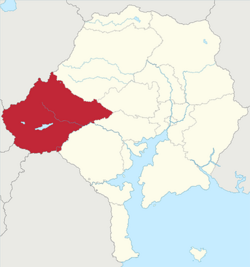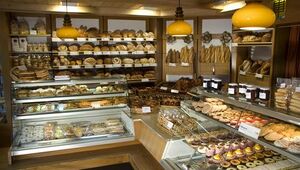Vaellenia: Difference between revisions
No edit summary |
|||
| Line 79: | Line 79: | ||
===Architecture=== | ===Architecture=== | ||
[[image:Colmar - Alsace.jpg|thumb|right|250px|Old market district, ''Baraersva'' in Berghelling]] | |||
Architecture in Vaellenia is somewhat different from the rest of metropolitan Midrasia, particularly in regards to historical buildings within the region. Owing to the region's location in western Midrasia, Vaellenia remained generally untouched by major conflicts within the nineteenth and twentieth centuries, allowing it to retain many of its medieval structures. Though {{wp|baroque architecture|baroque}} buildings continue to be prominent within major cities such as Berghelling and Rondouh, {{wp|gothic architecture|gothic}} and {{wp|romanesque architecture|romanesque}} buildings are far more prevalent in Vaellenia than the rest of the country. Notable medieval buildings in Vaellenia include the Church of Saint Para, Savoyard Castle, as well as many of the structures in the ''Baraersva'' district of Berghelling. | |||
Berghelling as one of Midrasia's major cities also has a considerable amount of {{wp|modern architecture}}, owing to its status as a key financial hub. Much of this architecture is located within the city's business and commercial districts and usually take the form of glass and steel skyscrapers and office blocks. A considerable skyscraper boom took hold within the city took place during the city's economic rise of the late 1990s, ensuring that the city plays host to one of Midrasia's tallest skylines. | |||
===Sport=== | ===Sport=== | ||
[[image:BerghellingDerby.jpg|thumb|right|250px|Berghelling derby in 2016]] | [[image:BerghellingDerby.jpg|thumb|right|250px|Berghelling derby in 2016]] | ||
Revision as of 17:16, 25 March 2019
This article is incomplete because it is pending further input from participants, or it is a work-in-progress by one author. Please comment on this article's talk page to share your input, comments and questions. Note: To contribute to this article, you may need to seek help from the author(s) of this page. |
Vaellenia | |
|---|---|
Autonomous Region of Midrasia | |
 | |
| Country | |
| Capital | Berghelling |
| Government | |
| • First Minister | Karine Passereau (AP) |
| Area | |
| • Total | 96,240.83 km2 (37,158.79 sq mi) |
| Population | |
| • Total | 14,874,082 |
| • Density | 154.55/km2 (400.3/sq mi) |
| Demonym | Vaellenian |
| Time zone | GMT |
| Nominal GDP | $741.8 billion |
| GDP per capita | $49,874.83 |
Vaellenia, sometimes referred to as Alpiens, is an autonomous region in western Midrasia. The region is bordered by the Midrasian regions of Padania, Piemonte, and Rhone. Vaellenia also shares its borders with Aquidneck, the Arzvan Republic, Cuirpthe, and tir Lhaeraidd. The region comprises 96,240.83 square kilometres (37,158.79 sq mi) making it the largest region in the country in terms of area. Vaellenia is also the largest region in mainland Midrasia in terms of population at 14,874,082. Originally Vaellenia comprised two regions within Midrasia, that of Vaellenia and Hivoir. However, upon the creation of the Vaellenian autonomous administration in 1985 the two regions were merged. The region's capital is located in the city of Berghelling, the largest in Vaellenia, which also plays host to the region's devolved parliament.
Vaellenia originally played host to a number of Thiaric tribes before its conquest by the Alydian kingdoms during the Western Crusades. Following this, the territory became part of the Grand Duchy of Alpiens, a crusader kingdom created to defend Alydianism's western frontier and proselytize the local population. Over time however, Alpiens became increasingly dependant on the newly formed Midrasian kingdom, ultimately entering a personal union when the Duke of Alpiens acceded to the throne of Midrasia as Louis VI. With the overthrow of the Midrasian monarchy in 1624 Vaellenia became a significant royalist stronghold, though proved unable to resist the Republican forces, ultimately being incorporated into the newly proclaimed Midrasian Republic. Over time the region saw an increasing influx of Midrasian settlers, significantly altering the cultural outlook of Vaellenia. Despite attempts at resistance, notably during the Vaellenian Rising, the region remained firmly under Midrasian control. During the industrial revolution, Vaellenia underwent considerable economic development, transforming the region into an industrial powerhouse with key industries in ironworking and textiles. Nevertheless, the region underwent significant economic decline during the 1970s and 80s due to de-industrialisation. Though Vaellenia has endured considerable political strife during the twentieth century, the creation of the autonomous administration in 1985 has alleviated many of these issues. Today Vaellenia remains a key player in Midrasia, boasting a significant technology, manufacturing and agricultural sector.
Much of the region is mountainous due to its location near the Vaellenian mountains from which the region takes its name. The highest point in Midrasia, Mount Elydia at 4,524.65 metres is located within the region. Most settlements within Vaellenia are situated along the two most prominent rivers in the region: the Candare and Rhonde. Vaellenia is home to the largest number of lakes and national parks of any region in Midrasia, making it a considerably popular tourist destination.
Vaellenia exhibits considerable cultural distinctions from the rest of Midrasia, holding much in common with its Thiaric neighbours of Cuirpthe and tir Lhaeraidd. Vaellenian is an officially recognised language within the region and continues to hold significant influence within Vaellenia's more rural regions. However, despite this Thiaric influence, Midrasian culture has gradually gained prominence in the centuries since the territory's incorporation into Midrasia proper.
History
Geography
Politics
Economy
Demographics
Culture
National parks
Vaellenia has the largest number of national parks of any region of Midrasia at 32. These parks are primarily made up of lakes, forests and mountain trails. All national parks are maintained by the Vaellenian National Parks Trust which is administered by the region's devolved government. Many of these parks also contain considerable indigenous wildlife such as the alpine ibex, brown bear, and grey wolf. Access to sites with significant wildlife is restricted and heavily monitored by park rangers. The existence of these national parks makes Vaellenia a considerable tourist hub, attracting numerous domestic tourists each year but also a not insignificant numerous foreign tourists, particularly from neighbouring Asuran nations such as Aquidneck and Cuirpthe.
Architecture
Architecture in Vaellenia is somewhat different from the rest of metropolitan Midrasia, particularly in regards to historical buildings within the region. Owing to the region's location in western Midrasia, Vaellenia remained generally untouched by major conflicts within the nineteenth and twentieth centuries, allowing it to retain many of its medieval structures. Though baroque buildings continue to be prominent within major cities such as Berghelling and Rondouh, gothic and romanesque buildings are far more prevalent in Vaellenia than the rest of the country. Notable medieval buildings in Vaellenia include the Church of Saint Para, Savoyard Castle, as well as many of the structures in the Baraersva district of Berghelling.
Berghelling as one of Midrasia's major cities also has a considerable amount of modern architecture, owing to its status as a key financial hub. Much of this architecture is located within the city's business and commercial districts and usually take the form of glass and steel skyscrapers and office blocks. A considerable skyscraper boom took hold within the city took place during the city's economic rise of the late 1990s, ensuring that the city plays host to one of Midrasia's tallest skylines.
Sport
Vaellenia has a considerably rich sporting tradition dating back centuries. Owing to the region's cultural connections Vaellenia is a regular participant at the Cluichí Gaelacha, or Thiaric Games in tir Lhaeraidd. Furthermore, traditional Thiaric sports such as Thiaric football, handball and hurling maintain a significant presence throughout the region. Vaellenia is also renowned internationally in the boxing scene, producing some of the best boxers in international sport. Most notably, Vaellenian Devan Jarry was two-times world heavyweight boxing champion between 1982-1984 and 1986-1989. Additionally, the region is a prominent region for rugby much more so than the rest of Midrasia. Berghelling Wolves Rugby Club has long been a dominant force in Midrasian rugby having won more league titles than any other team in the country. However, association football is by far the most popular sport in Vaellenia, as is the case with the rest of Midrasia. The two most notable football teams from Vaellenia are FC Hellingbourg and Vaelleniana KF, both of which are based in the regional capital of Berghelling. Both teams have a bitter rivalry known as the Berghelling derby owing to the proximity of both teams along with cultural distinctions between each fan base. Whilst fans of Vaelleniana are mostly drawn from the region's native Thiaric descended population, fans of Hellingbourg have traditionally been drawn from the descendants of Midrasian settlers which came to the region from the fifteenth century onwards.
Cuisine
Vaellenian cuisine is comparable to that of northern Midrasia, emphasising soups, pork, beef, and lamb. The region is also renowned for its bakery culture, particularly within the city of Berghelling. Since the fourteenth century, bakers from across Asura would travel to the city to pursue culinary educations in one of its many Pâtisseries. Pastries such as crepes and bagels originate from the region, though Berghelling is also notable for its production of Cuirpthean pastries such as waffles. Historically, Berghelling has also been notable for its chocolate industry, with the Midrasian chocolate giant Tilly opening its first factory in the city in 1862.
Vaellenia is also known as a beer or cider drinking region in contrast with the rest of Midrasia's preference for wine. Beer gardens and festivals dedicated to beer drinking are common throughout the region. The production of beer is also a key industry in Vaellenia, having its origins in the beer purity law of 1457, known as the Urzh glanded. The law was introduced owing to the Duke of Alpiens' patronage of brewing and was instituted to provide a standard for production, limiting beer ingredients to only water, barley, and hops.



